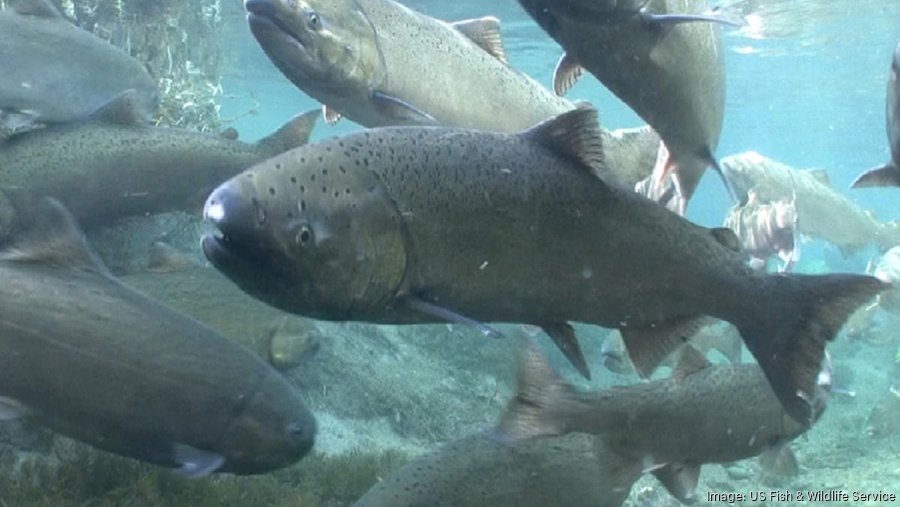The White House dropped a couple of weighty items into the lower Snake River dams discussion on Tuesday — a draft scientific assessment that makes a case for dam breaching as part of a comprehensive set of actions to recover imperiled salmon, and a study that puts the cost of replacing lost power from the dams at $11 billion in a best-case scenario.
The reports come amid intensifying Pacific Northwest debate over the fate of four dams on the lower Snake.
Locally on Tuesday, the environmental group Columbia Riverkeeper released a letter from more than five dozen Oregon businesses urging members of Congress from the state to work “to remove the Lower Snake River dams and re-invest in our communities and critical infrastructure.”
The federal reports were released by the Biden administration’s Council on Environmental Quality.
They are the latest contribution in a debate that has been roiling since Rep. Mike Simpson, an Idaho Republican, early last year floated a plan to breach the dams and spend billions in federal infrastructure funds to replace their benefits.
Conservationists and tribes see removing the dams as key to reviving salmon runs after decades of spending — around $24 billion in all — on restoration programs. Removal opponents say the dams are invaluable for power generation, freight movement and irrigation, and say ocean conditions could be a bigger problem for salmon than dams.
Snake River fish ‘recovery depends on large-scale actions’
The scientific assessment released by the White House came from the National Oceanic and Atmospheric Administration, with input from the U.S. Fish & Wildlife Service (USFWS), scientists and fish managers from the Nez Perce Tribe and the state of Oregon.
The report said that when it comes to Snake River Chinook salmon and steelhead, “recovery depends on large-scale actions, including breaching dams, systemically restoring tributary and estuary habitats, and securing a more functional salmon ecosystem.”
A White House news release noted that the administration has not endorsed “the particular actions identified in today’s draft science report.”
Nonetheless, CEQ Chair Brenda Mallory declared that “business as usual will not restore the health and abundance of Pacific Northwest salmon. We need a durable, inclusive, and regionally crafted long-term strategy for the management of the Columbia River Basin.”
Eastern Washington Rep. Cathy McMorris Rodgers and several Pacific Northwest Republican colleagues, including Rep. Cliff Bentz (D-Ontario), accused the White House of “cherry picking points to justify breaching the Lower Snake River Dams” in the scientific assessment.
“As the members of Congress representing the range of stakeholders engaged in recovering endangered salmon and preserving the Columbia River power system, we must point out the reality that the draft report by NOAA, FWS, Nez Perce Tribe, and state of Oregon fails to acknowledge that salmon returns on the Lower Snake River have shown encouraging gains since 2019,” they said in a news release.
Losing dams will add to energy-transition burden
The power-replacement study — the dams provide an average of 900 megawatts of power, enough to serve around 700,000 homes, as well as greater amounts of peaking power and other grid services — was done by the consulting firm E3.
It notes that “even with the dams in place, the region’s clean energy goals and potential electrification load growth drive a significant need for new resources.”
The study presented various scenarios for replacing the lost dam power, generally based on breaching of the dams in 2032, and looked at the likely costs out to 2045.
The $11.2 billion least-expensive scenario uses “emerging technologies” of small modular nuclear reactors and dual fuel natural gas-hydrogen combustion.
The study, though, notes that “the pace of their commercialization is highly uncertain.” Other scenarios eschew nuclear and rely more on solar, wind and storage, and grow the cost up to $19.6 billion. A scenario with no emerging technologies at all balloons the cost to $42 billion to $72 billion.
A recent study commission by Northwest RiverPartners, which advocates for retaining the dams, put the cost of replacing the dam power at $15 billion. And a draft report commissioned by U.S. Sen. Patty Murray and Gov. Jay Inslee, both Washington Democrats, estimated the cost at between $9.3 billion and $18.6 billion.
